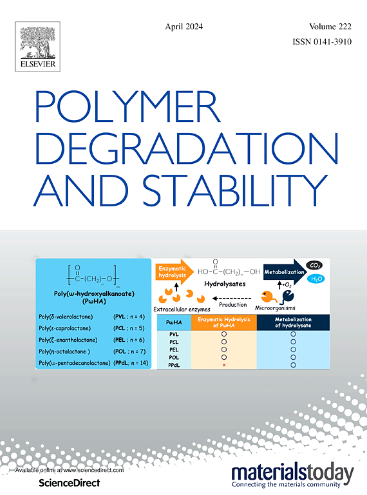Degradation of thermoplastic polymers for fused filament fabrication under (S)TEM electron beam irradiation
IF 6.3
2区 化学
Q1 POLYMER SCIENCE
引用次数: 0
Abstract
The structural characterization of polymers and, in particular, of those used in Additive Manufacturing (AM) technologies, is essential to improve the understanding of their structure-property relationship for promising high-performance applications. For this, (scanning) transmission electron microscopy-electron energy loss spectroscopy, (S)TEM-EELS is an outstanding tool for exploring materials chemical and structural characteristics at high spatial resolution. However, the high beam-sensitivity of soft materials, such as polymers, hinders the possibility of probing in-depth analysis provided by (S)TEM-EELS. In this work, we analyse the electron beam irradiation damage of four polymers commonly used in Fused Filament Fabrication (FFF), namely polylactic acid (PLA), polycaprolactone (PCL), acrylonitrile butadiene styrene (ABS) and acrylonitrile styrene acrylate (ASA). For this, sequential low-loss and core-loss EEL spectra have been recorded, and the related signals have been monitored as a function of the accumulated dose. Our results show that the critical electron doses using the specimen thickness variations are larger for polymers containing aromatic groups (ABS and ASA) than for aliphatic polymers (PLA and PCL). Regarding the different elements, a larger sensitivity to the electron beam of oxygen regarding carbon and nitrogen is also evidenced. Our results have shown that polymer degradation occurs to a larger extent in the initial steps of electron irradiation, for very low accumulated electron doses, meaning that care should be taken in the selection of the microscopy settings to avoid artefacts produced by the electron beam. Degradation pathways for the four polymers studied are discussed.
用于熔融长丝制造的热塑性聚合物在 (S)TEM 电子束辐照下的降解情况
聚合物的结构表征,尤其是增材制造(AM)技术中使用的聚合物的结构表征,对于更好地了解其结构与性能之间的关系以实现有前途的高性能应用至关重要。为此,(扫描)透射电子显微镜-电子能量损失光谱((S)TEM-EELS)是以高空间分辨率探索材料化学和结构特征的杰出工具。然而,聚合物等软材料的高光束灵敏度阻碍了(S)TEM-EELS 所提供的深入分析的可能性。在这项工作中,我们分析了熔融长丝制造(FFF)中常用的四种聚合物(即聚乳酸(PLA)、聚己内酯(PCL)、丙烯腈-丁二烯-苯乙烯(ABS)和丙烯腈-苯乙烯-丙烯酸酯(ASA))的电子束辐照损伤。为此,我们记录了连续的低损耗和核心损耗电子能谱,并监测了相关信号与累积剂量的函数关系。结果表明,对于含有芳香族基团的聚合物(ABS 和 ASA),利用试样厚度变化得出的临界电子剂量要大于脂肪族聚合物(PLA 和 PCL)。在不同元素方面,氧对电子束的敏感度也高于碳和氮。我们的研究结果表明,在电子辐照的初始阶段,即使累积电子剂量很低,聚合物的降解程度也较大,这意味着在选择显微镜设置时应注意避免电子束产生的假象。本文讨论了所研究的四种聚合物的降解途径。
本文章由计算机程序翻译,如有差异,请以英文原文为准。
求助全文
约1分钟内获得全文
求助全文
来源期刊

Polymer Degradation and Stability
化学-高分子科学
CiteScore
10.10
自引率
10.20%
发文量
325
审稿时长
23 days
期刊介绍:
Polymer Degradation and Stability deals with the degradation reactions and their control which are a major preoccupation of practitioners of the many and diverse aspects of modern polymer technology.
Deteriorative reactions occur during processing, when polymers are subjected to heat, oxygen and mechanical stress, and during the useful life of the materials when oxygen and sunlight are the most important degradative agencies. In more specialised applications, degradation may be induced by high energy radiation, ozone, atmospheric pollutants, mechanical stress, biological action, hydrolysis and many other influences. The mechanisms of these reactions and stabilisation processes must be understood if the technology and application of polymers are to continue to advance. The reporting of investigations of this kind is therefore a major function of this journal.
However there are also new developments in polymer technology in which degradation processes find positive applications. For example, photodegradable plastics are now available, the recycling of polymeric products will become increasingly important, degradation and combustion studies are involved in the definition of the fire hazards which are associated with polymeric materials and the microelectronics industry is vitally dependent upon polymer degradation in the manufacture of its circuitry. Polymer properties may also be improved by processes like curing and grafting, the chemistry of which can be closely related to that which causes physical deterioration in other circumstances.
 求助内容:
求助内容: 应助结果提醒方式:
应助结果提醒方式:


